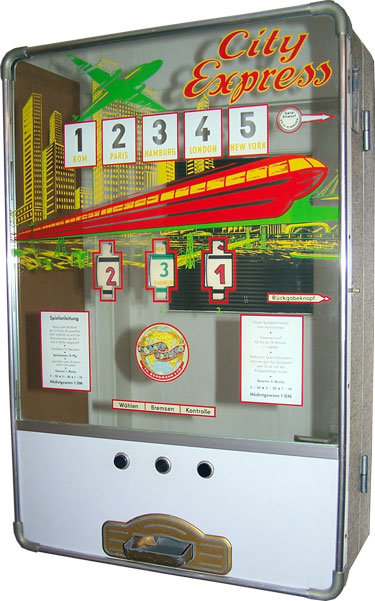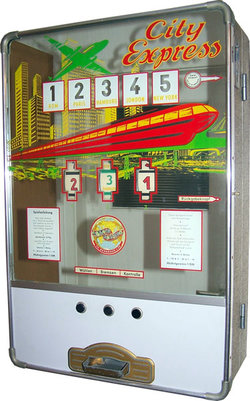- Home
- Replacement Artwork,logos,etc Available
- The Allwin Arcade
- Trade Stimulators
- The Strange & Unusual
- The Aristocrat Collection
- The Bally Collection
- The Bell-Fruit collection
- The BDR/BMR Collection
- The Bryans Collection
- The Buckley collection
- Caille Brothers Collection
- Working Models
- The Groetchen collection
- The Hawtin's Collection
- The Jamieson's Collection
- The Jennings collection
- The Mills Collection
- The NSM (Bingen) Collection
- The Oliver Whales Collection
- The Pace Collection
- The Parkers Collection
- The Rock-ola collection(slot machines)
- The Ruffler & Walker Collection
- The SEGA Collection
- the Shefras collection
- The TH.Bergmann Collection
- The Tom Boland collection
- The Watling collection
- The Whittaker Bros Collection
- the Wondermatics collection
- The Wulff Collection
- The Juke Box Age
- Coin Operated Cranes & Diggers
- Coin Operated Shooting Games
- Coin Operated Weight Scales
- slot machine coins & tokens for sale
- Amusement Arcades from the Past
- The British Seaside Pleasure Pier
- The Market Place
- Coin Operated Related Seaside Postcards
- See a Selection of the More Complex Machines at Work
- Stuart Dale's Imperator Rebuild
- Stuart Dale's Steam Shovel Project
- The "Allwin" Machine
- Useful Links
- The Rye Heritage Ctr Collection of Working Models
- Williamson's Vintage amusement arcades
- Contact Us

TH.Bergmann & Co 1936-1968

Thomas Bergmann entered the slot machine market in 1935 and his first machine was probably the Hinen model A football table game closely followed with a shooter called "Sharpshooter". These must have had some success as a year later he formed TH.Bergmann & Co which continued under that name for the next 30 years. Bergmann seems to have avoided the Nazi period of gaming machine bans because, at this time, he made only amusement machines with no payouts.

The Hinein (model B) 1935/6
This is not a pinball site but it's impossible not to involve pin balls when looking at TH Bergmann for they produced some of the best Deco style pinball artwork and cases ever made and many of the pinball themes (and artwork) and experience crossed over to there slot machines in later years.


Alarm (1958) Favorit (1939)


The particularly nice artwork on the "Clipper" 1954
Not surprisingly all production seems to have stopped when WW2 started and did not resume until the late 1940s when it was once again pinballs that were the main product, but by 1950 they were making several drop case style machines like the Jupiter as well as several allwin style games like their Derby.


Jupiter (1950) Derby (1950)
Restricted by the odd German slot machine laws of the time which meant all slots had to be broken up or exported after three years Bergmann took a different route than their competitor Wulff, rather than make cheap machines mainly for the home market and then export them cheap after three years to other countries Bergmann looked for export markets for their better-made machines from new.

Government-issued date restriction(1959 to 1962) licence for a Union Lexus
This was to prove a success for them in later years as their product range changed. Like the other German makers, they were quick to see the advantages of electro-mechanical machines and with their extensive pinball building experience, they were making a large selection of these by 1954. An extensive range of machines yes but, like other German makers, different on the outside but much the same on the inside. In another cost-effective move, they used much of their existing pinball artwork in the new slots.


More nice deco artwork on the "City Express" Horse race-themed Gluckszahl artwork
previously used on their "Nord-Express" pinball previously used on one of their "Turf" pinballs
The Export network already being built up really came into its own in the second half of the 1950s with the new demand for jukeboxes. Bergmann was early into this market making several impressive units. For some reason, Germany was a big user of jukeboxes after the war and by 1960 50,000 were in use in Germany against only 20,000 in the Uk and Ernst Bergamnn (now running the business)saw the untapped market in the Uk coupled with his export network as a great opportunity and grabbed it. So big was the demand in the UK for jukeboxes at the time American makers couldn't cover the numbers needed mostly because of the time it took to deliver and it was Bergmann who first used airfreight to cut delivery times to the UK, Italy and, surprisingly, to the USA where demand was so high the American makers couldn't satisfy the domestic market's needs.

The best selling Symphonie 80
As early as the mid 1950;s the company was making an interesting range of console slot machines in different styles including electric flasher types and in 1962 also launched two new shooters the Arizona (mechanical) and the Safari (electric) using a BB type gun made by the Diana air gun co.


Universum Imperitor

Nepomuk(prototype)

Arizona Shooter (1962)
In 1966 things didn't exactly start to go wrong but the company fell foul of a few unusual problems. On the strength of their success, they built a very modern new factory outside Hamburg only to find the labour shortage in Germany meant they couldn't get enough workers to get the plant working at full capacity and they were forced to bus in workers from Hamburg just to keep it going. Added to this the jukebox demand was slowing and planned exports of slots to the USA were no longer on the cards. Added to this their range of machines was falling into two distinct types, very plain and boring and very complex and confusing. The company was still doing well but consolidation was the way forward and in 1968 TH.Bergmann merged with other companies but still worked within the gaming industry, these eventually became Crown Technologies Gmbh(Germany) in 2007 who are still making slot machines today and very nice ones at that. Although described on the companies web site as "money laundering machines" in the poor English translation (or is it so wrong?)

2017 Admiral Crown II
A few of the Bergmann range of machines


The Rotery(1956) a great light-up machine Rouletta(1957)
I have one of these & it's a surprisingly addictive game


The Antieke Shooter was a very successful machine, a rapid-fire two-player game with a time limit,
there were several models, this is a (B)


The Elektro Bomber was a huge early success and went a long way to getting the company going, this flipperless flatbed pinball with no rear box featured a rotary counter and an early mercury tilt switch (visible in photo 3 to the right of the toothed wheel). At least four versions of this machine were made





The unique Revue 1957(are those legs original?) Nord Express


The Casino (The Rotary with a different glass) Union Lexus 1958


beautifully cased Komet and "Stop" both 1954


The rather odd compact pinball "Pasch" 1951 Ultra Bell 1954


Jupiter coin drop game 1950 Favorit allwin style game 1950


Trumpf 1959 The oddly named "Hobby" 1965


The rather uninspiring Topfit 1967 Super 1954


Two of the last machines perhaps getting a little overly complex and confusing to players of the day
Super Six 1967 Max & Moritz (themed on the 1895 German dark verse
book about two naughty boys) 1965
625363
